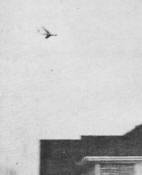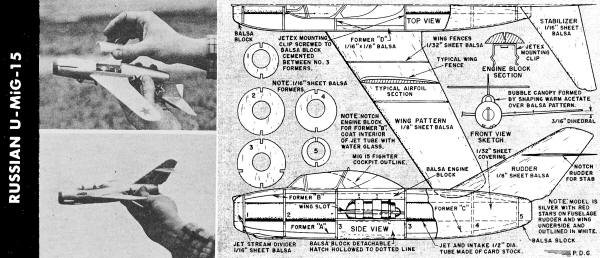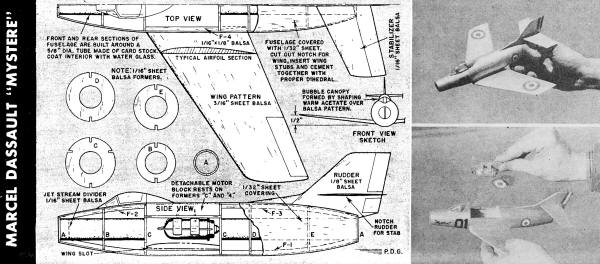|
The Russian
Mikoyan-Gurevich
MiG-15 (entered into service in 1949) and French
Dassault MD.452 Mystère
(entered into service in 1951) jet airplanes were prominent first in the Korean
War and then into the Vietnam era. They were two of the earliest jet fighters in
air warfare. The U.S. contribution included the McDonnell
F-4 Phantom (entered into service in 1948), the
North American
F-86 Sabre (1949),
Lockheed P-80
Shooting Star (1945), and the
Grumman F9F Panther
(1949). Many of the American jet planes were being modeled around 1956, when this
issue of Young Men magazine came out, but at least in domestic magazines,
plans for foreign jobs were fairly rare. Here are plans for the two aforementioned
Russian and French jets which use the Jetex 50
engine for propulsion. Construction is all balsa, consisting of a minimal framework
covered with 1/32" balsa. The Jetex 50 is mounted to a removable balsa block,
to facilitate loading and unloading the fuel. The plans call for a "water glass" coating inside
the rolled cardboard jet exhaust tube. I had never heard of it, but per Wikipedia:
"Sodium silicate is the technical and common name for a mixture of such compounds,
chiefly the metasilicate, also called waterglass, water glass, or liquid glass.
The product has a wide variety of uses, including the formulation of cements, coatings,
passive fire protection, textile and lumber processing, manufacture of refractory
ceramics, as adhesives, and in the production of silica gel. The commercial product,
available in water solution or in solid form, is often greenish or blue owing to
the presence of iron-containing impurities." These would be a great project if only
there was a modern version of the Jetex engines and fuel pellets readily available.
Russian and French Scale Jet Planes - They Really Fly!
 A great deal of time and effort has been
devoted to Jetex-powered models of the contest and sailplane variety in the past
few years, and very little to scale models. In this respect many model builders
are missing the boat as Jetex engines are uniquely adaptable to scale models of
jet fighters and similar aircraft. The Jetex #50 engine, for instance, is small
enough to be completely covered and easily cooled, yet gives enough power to fly
a model at a fast clip. Using the Jetex #50 engine as a starting point, a number
of scale models of current jet fighters were built with spans of from 8" to 12".
The models were of all-balsa construction and were designed to combine accurate
scale with the maximum of flying pleasure. To all outward appearances they look
like solid display models. In general both straight-wing and swept-wing types perform
equally well in flight. This puts the majority of today's jet fighters within reach
of the model builder as possible prototypes. A great deal of time and effort has been
devoted to Jetex-powered models of the contest and sailplane variety in the past
few years, and very little to scale models. In this respect many model builders
are missing the boat as Jetex engines are uniquely adaptable to scale models of
jet fighters and similar aircraft. The Jetex #50 engine, for instance, is small
enough to be completely covered and easily cooled, yet gives enough power to fly
a model at a fast clip. Using the Jetex #50 engine as a starting point, a number
of scale models of current jet fighters were built with spans of from 8" to 12".
The models were of all-balsa construction and were designed to combine accurate
scale with the maximum of flying pleasure. To all outward appearances they look
like solid display models. In general both straight-wing and swept-wing types perform
equally well in flight. This puts the majority of today's jet fighters within reach
of the model builder as possible prototypes.
- By Richard M. Bueschel

Jetex 50-Powered Russian Mikoyan-Gurevich MiG-15 Flying Model
Plans

Jetex 50-Powered French Dassault MD.452 Mystère Flying Model
Plans
Fun size U-MiG-15 and Mystere plans and instructions are part of Group Plan #E56A
by Hobby Helpers, 770 Hunts Pt. Ave., New York 59, N. Y. (50¢).
|




